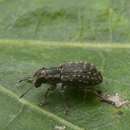Associations
provided by BioImages, the virtual fieldguide, UK
Foodplant / feeds on
larva of Sitona hispidulus feeds on root of Medicago
Foodplant / feeds on
larva of Sitona hispidulus feeds on root of Trifolium
Foodplant / feeds on
larva of Sitona hispidulus feeds on root of Medicago sativa
Conservation Status
provided by University of Alberta Museums
Abundance of this pest species is variable over time and space (Campbell et al. 1989).
- license
- cc-by-nc
- copyright
- University of Alberta Museums
Cyclicity
provided by University of Alberta Museums
Weevils are active from spring to fall, when temperatures are 10 to 24° C (Campbell et al. 1989).
- license
- cc-by-nc
- copyright
- University of Alberta Museums
Distribution
provided by University of Alberta Museums
This species has been recorded in southern regions of most of the Canadian provinces, with the exception of Manitoba; in Alberta, records show that it occurs in the Lethbridge and Taber counties (Bright and Bouchard 2008). There are also records of the weevil in Alaska and northern British Columbia and it has been recorded as far south in North America as eastern Mexico (Bright and Bouchard 2008). This spcies was likely introduced to North America from Europe (Campbell et al. 1989).
- license
- cc-by-nc
- copyright
- University of Alberta Museums
General Description
provided by University of Alberta Museums
Adult S. hipidulus are distinguished from other adult Sitona weevils by the presence of a row of long and erect setae along the median of each elytral interstria. Eyes are weakly convex. Rostrum is without carnia. Frontal rostral groove extends from near the level of the antennal groove to above the upper eye level. Bodies are stout, ranging in length from 3.2 to 4.0 mm. Bodies are black, while antennae, tarsi and tibiae are a dark reddish black colour. The pronotum is wider than it is long, widest in the middle and strongly arcuate. The pronotal surface is shiny with large scattered deep punctures, each puncture possessing an erect seta. The groove on the prosternum is evident between the fore coxae and the anterior of the prosternum. The elytra are parallel for two thirds of the length and may be slightly arcuate. The elytral surface has large strial punctures that are not visible due to dense surface scales. The vestiture consists of dense, small scales, completely covering the interstriae and striae and includes median interstrial rows of erect, long and hair-like setae. Scales may be light brown, forming indistinct brownish spots. (Adapted from Bright 1994, Bright and Bouchard 2008)
- license
- cc-by-nc
- copyright
- University of Alberta Museums
Habitat
provided by University of Alberta Museums
Agricultural systems where clover, alfalfa, vetch and sweet clover are found (Campbell et al. 1989).
- license
- cc-by-nc
- copyright
- University of Alberta Museums
Life Cycle
provided by University of Alberta Museums
Eggs, larvae and adults of this univoltine species all have the potential to overwinter (Davidson and Lyon 1979, Campbell et al. 1989). Overwintering occurs beneath clover and alfalfa debris (Campbell et al. 1989). Unlike S. lineatus and S. cylindricollis, new generation weevil adults are not sexually immature; therefore, mating and oviposition may occur in the autumn (Campbell et al. 1989). Migration to and from overwintering locations occurs largely by walking, as individuals of this species tend to be weak fliers (Campbell et al. 1989). Peak weevil activities, including mating, migrating, egg-laying and feeding occur when mean daily temperatures range between 10 and 24° C (Campbell et al. 1989), and Culik and Weaver (1994) identified three peak times of crawling activity, occurring in April/May, mid-June to mid-July and September to mid-November. Eggs may be laid at temperatures as low as 4° C at night or during daylight hours, and are deposited at the bases of plants, under debris, or on stems, stipules and leaves (Bigger 1930, Campbell et al. 1989). On average, 167 eggs are produced per female (Bigger 1930). Incubation times are dependent upon the geographic region inhabited, and range from 6 days to several weeks (Campbell et al. 1989). If laid in autumn, eggs do not hatch until spring (Bigger 1930). Larvae feed upon roots and root nodules for a total of five larval instars, the duration of larval feeding varies between regions (Tan and Hower 1991). Early instars feed within root nodules and later instars leave the nodules and feed on fibrous root tissues (Campbell et al. 1989, Tan and Hower 1991). Pupation occurs in the soil, within 8 cm of the soil surface, and adults emerge as early as late June in the United States (Bigger 1930), with emergence continuing throughout the summer.
- license
- cc-by-nc
- copyright
- University of Alberta Museums
Trophic Strategy
provided by University of Alberta Museums
Larvae feed upon the roots and root nodules of red clover (Trifolium pretense), white clover (Trifolium repens) and alfalfa (Medicago sativa) (Murray and Clements 1994, Murray and Clements 1995). Root nodules are often destroyed and taproots may be girdled (Davidson and Lyon 1979, Campbell et al. 1989). Adults feed on leaves of clover and alfalfa plants, creating crescent shaped notches along the leaf margin (Campbell et al. 1989, Barratt and Byers 1992).
- license
- cc-by-nc
- copyright
- University of Alberta Museums
Sitona hispidulus
provided by wikipedia EN
- license
- cc-by-sa-3.0
- copyright
- Wikipedia authors and editors
Sitona hispidulus: Brief Summary
provided by wikipedia EN
Sitona hispidulus is a species of weevil native to Europe. Invasive to Asia and North America.
- license
- cc-by-sa-3.0
- copyright
- Wikipedia authors and editors

